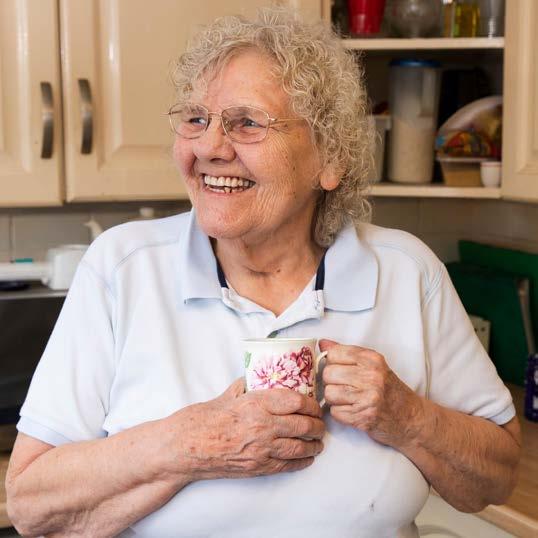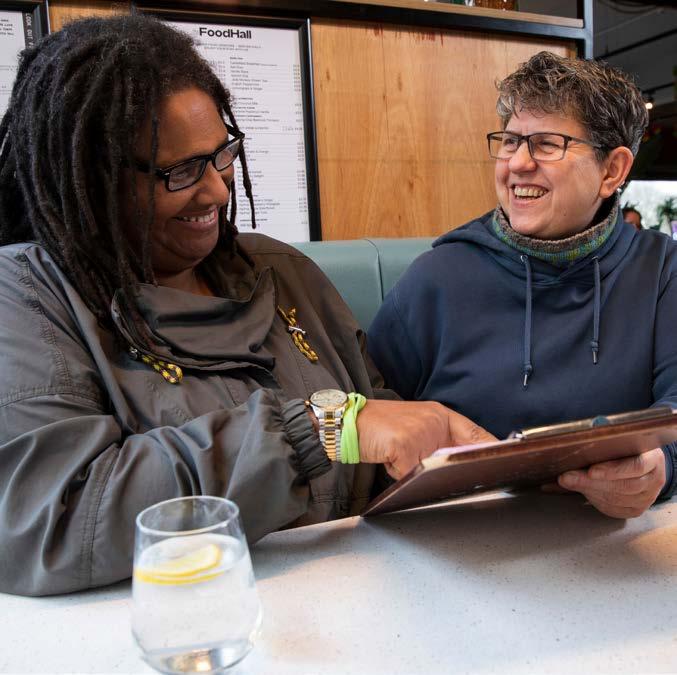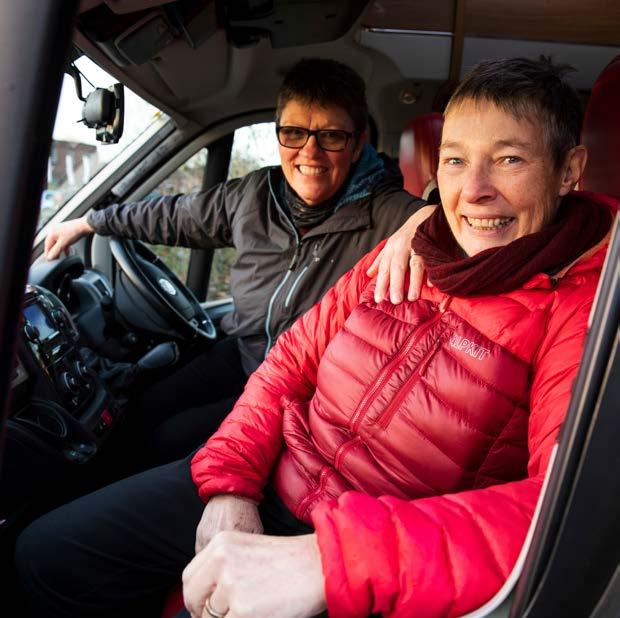Becoming a Dementia Supportive Business & Community: A Practical Guide
Teresa Davies, Catherine MacLeod and Hannah Jelley

Acknowledgements
This guide was co-created with experts by experience who are living with a diagnosis of dementia working together with academics in dementia research at Bangor University.



Thank you for the valuable contributions made by Chris Roberts, Agnes Houston, the Caban group, and Ian Davies-Abbott.
The work was undertaken by the Celtic Advanced Life Science Innovation Network (CALIN), an Ireland Wales 2014–2020 Programme Part Funded by the European Regional Development Fund through the Welsh Government. Grant and operational case number 80855.



Information, resources, and links included in this booklet were correct at time of production (March 2023) but may change over time.

2. Becoming a Dementia Supportive Business & Community Becoming a Dementia Supportive Business & Community 3.
Introduction
How accessible is your business and community for someone with dementia? It doesn’t matter what industry you work in or what community you are a member, it is inevitable that you will come across someone impacted by dementia.

The number of people living with dementia or supporting someone with the condition is increasing. However, even small changes can make a big difference to support people affected by dementia.
We can all play a part in making life a little easier for people affected by dementia.
Contents
This guide will help you to understand dementia and the challenges people encounter.
It includes practical tips and useful information to enable you to support people affected by dementia.
4. Becoming a Dementia Supportive Business & Community Becoming a Dementia Supportive Business & Community 5.
Understanding Dementia 6. What is Dementia? 6. How does the brain work? 7. What happens when someone develops dementia? 7. Types of Dementia 8. Identifying and Recognising Challenges 10. Thinking and Memory Challenges 12. Visual and Sensory Challenges 14. Physical and Communication Challenges 16. Understanding Reactions and Behaviours 18. Supporting People to Live as Well as Possible with Dementia 20. Positive Mindset 21. Communication 22. Navigation 23. Understanding how to provide practical support 24. Resources 28. Reflecting & Making Changes 30.
Understanding Dementia
How does the brain work?
Neurons are cells in the brain. These brain cells send and receive electrical and chemical signals to transfer information between different parts of the brain and body. Your brain interprets these signals, for example by telling you that you are hot or cold, or feel tired.
on living with mixed Vascular and Alzheimer’s
What is Dementia?
Dementia is not one specific illness. Dementia is an umbrella term used to describe many different types of conditions that cause symptoms that effect thinking and memory. These symptoms get progressively worse over time.
Dementia is not a normal part of ageing. Dementia is the result of physical illnesses that affect the brain. Whilst older people are more at risk of dementia, younger people can also be diagnosed.
Whilst memory loss is the most commonly associated symptom, dementia may also affect communication, thinking, emotions and personality.
The symptoms, challenges, and progression of the illness vary from person to person, regardless of dementia type.
What happens when someone develops dementia?
Damaged brain cells caused by dementia reduce the brain’s ability to send and interpret signals.
The areas of the brain where cells are damaged influences the symptoms a person experiences. For example, if damage occurs at the back of the brain a person might have trouble with their vision, however if damage is to the side of the brain they might experience communication difficulties.
Current research suggests that for some types of dementia, such as Alzheimer’s disease, brain cells are damaged by the build-up of proteins. Whilst these proteins are present in everyone’s brain, in Alzheimer’s disease they clump together. The damage spreads from one area to another as the condition progresses with symptoms getting worse over time.
Some types of dementia, such as vascular dementia, are caused by damaged blood vessels in the brain which disrupt the flow of blood and oxygen. Risk factors for vascular dementia include stroke, heart disease and diabetes.
6. Understanding Dementia Understanding Dementia 7.
When you meet one person with dementia, you have met one person with dementia, everybody is different.
Chris
Dementia.
Types of Dementia
There are many different types of dementia, but the four most common types of dementia are:

■ Alzheimer’s disease
■ Vascular dementia
■ Lewy Body dementia
■ Frontotemporal dementia
There are also rarer forms of dementia, and some people have mixed dementia which includes more than one type.
Although the experience is different for each person, common symptoms include:
Alzheimer’s Disease
■ Memory problems
■ Difficulty planning tasks
■ Difficulty finding the right words
■ Difficulty with numbers
Vascular
■ Changes in mood
■ Difficulty with attention, planning and reasoning
■ Muscle weakness
■ Movement problems
Lewy Body
■ Visual hallucinations
■ Sleep disturbances
■ Repeated falls and fainting
■ Slower in physical movements
Frontotemporal
■ Personality changes
■ Lack of social awareness
■ Language problems
■ Obsessive behaviour
8. Understanding Dementia Understanding Dementia 9.
Identifying & Recognising Challenges
Everyone’s experience of dementia is unique which can make it difficult to recognise when someone may be experiencing a challenge and could use help. Behaviours that might seem unusual could be a sign that someone needs support.

People may experience difficulties with their thinking and memory. They may also experience visual and sensory challenges, or physical and communication difficulties.
Agnes on living with Alzheimer’s dementia.
10. Identifying & Recognising Challenges Identifying & Recognising Challenges 11.
My Dementia is more than memory loss so environmental design is very important to me.
Shopping is no longer pleasurable or safe due to poor acoustics and design.
I can’t think due to crescendo of noise.
Thinking & Memory Challenges
People living with dementia might experience difficulties with thinking and memory, however these will be different for everyone and may change over time.
Some areas people may experience challenges include:
Planning and Order:
■ Difficulty with everyday activities that require preparation, such as travelling or shopping.
■ Difficulty doing activities in the right order, such as putting on shoes before socks.
■ Difficulty with multi-tasking, such as coordinating a knife and fork.
Memory:
■ Difficulty remembering more recent events or information.
■ Difficulty finding the right word or number.
■ Difficulty finding things or feeling lost.
■ Although someone may not remember an event or person, often they can remember how they felt, such as joy, sadness, or love.
Confusion:
■ Difficulties counting money, such as recognising the value of each coin and calculating the amount.
■ Mixing up days and times, such as thinking that night is day.
■ Difficulty concentrating and understanding information, such as following the storyline of a book or film.
12. Identifying & Recognising Challenges Identifying & Recognising Challenges 13.
Visual & Sensory Challenges
People living with dementia might experience visual and sensory challenges which can affect how information is perceived. The brain might not be able to interpret what the eyes are seeing, or other senses are experiencing.
Hearing:
■ Experiencing hypersensitivity to noise, such as sounds being experienced as louder than they are for others.
■ Ambient sounds causing distraction and confusion, such as music in shops making it difficult to concentrate.
People may experience challenges with:
Vision:
■ Difficulty interpreting patterns or dark spaces, such as perceiving a black mat as a hole in the floor, or curtains with a swirly pattern as snakes climbing a wall.
■ Difficulty with objects that look similar but have different functions, such as hairbrushes and toothbrushes.
■ Difficulty separating objects when things are a similar colour, such as knowing if the toilet lid is up or down because it is the same colour as the seat.
■ Difficulty with depth perception, such as if there are stairs, a slope, or curb edges.
■ Difficulty with light, such as shadows making it difficult to know where you can step.
■ Multiple conversations taking place in a small space can be overwhelming and make it hard to focus, such as several people talking at once over dinner.
■ Repetitive sounds, such as fire alarms, can cause tinnitus-like symptoms.
■ Sounds may trigger people to re-experience past memories, such as loud bangs triggering memories of war.
Touch, Taste & Smell:
■ Difficulty interpreting temperature, such as knowing if water is boiling or cold.
■ Changes in taste, such as experiencing food as more bitter or sweet than before.
■ Smells may trigger past memories, such as baking bread causing people to re-live childhood experiences.
14. Identifying & Recognising Challenges Identifying & Recognising Challenges 15.
Physical & Communication Challenges
People living with dementia, particularly in later stages of the condition, might experience physical challenges due to dementia, medication, or other co-occurring medical conditions. People might struggle with:
Communication:
■ Difficulties finding the words wanted.
■ Using the wrong words or similar words (such as feet instead of hands), or describing something instead of using the specific word.
■ Using facial expressions and gestures to express needs.
■ Experiencing frustration when struggling to communicate.
■ Difficulties understanding what is being said.
Mobility:
■ Difficulty standing or walking.
■ Changes in how they walk, for example changes in speed, stride, or leaning forwards or to one side.
■ Difficulty sitting down or getting up from a chair.
Falls:
■ People might experience changes in balance.
■ Visual perception issues, such as noticing curbs or stairs, can increase the risk of falling.
Continence:
■ Difficulties noticing a full bladder.
■ People might need to use a toilet more urgently.
■ Difficulty locating and recognising a toilet.
■ Spatial awareness problems, such as difficulty judging distances increases risk of knocking into furniture or missing a chair when sitting.
16. Identifying & Recognising Challenges Identifying & Recognising Challenges 17.
Understanding Reactions & Behaviours
Unexpected situations can create strong responses and result in people behaving in what seems like unusual ways. However, understanding the reasons behind people’s reactions can help us to make sense of these behaviours.
1. Feelings
Surprising situations might cause us to feel strong emotions, such as feeling afraid or threatened if we don’t understand what is happening.
2. Assessment
Usually, we pause to consider and assess a situation to try to understand what is happening. However, dementia can make it difficult for people to do this.
3. Action
The action we take depends on how we interpret the situation. However, when we don’t fully understand what is happening or why, we act in ways which may seem inappropriate to others who have interpreted the situation differently.
Consider, you are lying in bed at home and someone you do not recognise comes into your room and starts to undress you. You don’t know why.
■ How would you feel and what would you do?
■ What reasons might there be for this situation?
■ Is someone attacking you?
■ Are they trying to help you get ready?
Does your initial reaction seem appropriate when considering different interpretations of the situation?
This is a scenario that people living with dementia might encounter, particularly if they have problems recognising people. In later stages of dementia people might struggle to dress and their partner or carer might help. However, if they do not recognise the person they may struggle to understand why this person is undressing them and will react to what they feel is happening.
18. Identifying & Recognising Challenges Identifying & Recognising Challenges 19.
Supporting People to live as well as possible with dementia
It is important to remember that there is more to a person than dementia.
Although there are many challenges that people living with dementia experience people can still live fulfilling lives. We can all play a part in supporting people to do this.
In this section you will find some practical tips and helpful actions that you can take to support people living with dementia.
Positive Mindset
How you respond to a person living with dementia is really important and can have a big impact.
Even if only brief, a positive interaction can have a long-lasting affect, leaving people with positive feelings of being valued and respected. Stereotypes can be harmful and make people worry about being honest and reluctant to seek help. See the person not the dementia.
■ Don’t be afraid to offer assistance. Whilst people don’t always need or want help, they will appreciate the offer. Offering help can give people confidence to seek help when needed in future.
■ Avoid making assumptions about what someone’s needs are, ask if they are comfortable to share them with you. Whilst you might want to relate and put people at ease with your own experiences, it is important to acknowledge their experience and appreciate differences.
Don’t tell us what we can’t do, help us do what we can
Teresa on living with Alzheimer’s dementia.
■ Be respectful and mindful of how someone might feel. Listen to what is communicated, acknowledge preferences and choices, and value others’ views.
■ Treat people with respect and dignity, consider how you would like to be treated.
■ With kindness and compassion, you can make a huge difference.
20. Supporting People to live as well as possible with dementia Supporting People to live as well as possible with dementia 21.
Communication
Communication is important for everyone. It is how we express ourselves.
We communicate through language and behaviours. This includes spoken and written words, facial expressions, gestures, and visual information.
■ It is important to look beyond words, by listening to the tone of the person’s voice and observing their expressions. If someone is struggling to find the right words, what they say may not match the message they are trying to convey.
■ Be aware of your body language which might unintentionally give the wrong message. For example, you are trying to be patient, but glancing at your watch suggests you are rushed.
■ Speak clearly using short simple sentences that are easy to understand.
■ Avoid listing lots of options together as this may be too much information for the person. Instead, provide two or three choices.
■ Provide appropriate and timely support by patiently waiting for people to speak. Don’t be tempted to speak for or over someone, people will let you know if they need help.
■ Be aware of visual symbols used to signal information, such as on badges, lanyards, and bracelets. For example, a sunflower lanyard indicating hidden disabilities.
■ If someone is lost or distressed, you can offer to contact someone for help. People may have an emergency contact card.
■ In group discussions it can be difficult to speak. Visual aids, such as cards which say ‘I want to speak’ can let you know people want to say something.
Navigation
Making small changes to environments can help people make sense of spaces and move around safely. Even if environmental changes cannot be made, understanding how the environment effects someone’s behaviour will enable you to offer the most appropriate support.
■ Clearly signpost areas and facilities. Make it clear how to enter and exit spaces, once in a space it is not always obvious how to get out. For example, in toilets multiple doors may be confusing and the main exit not clear.
■ Contrasting colours make it easier for people to distinguish information, including boundaries and depth. For example, a sandwich on a white plate can be difficult to see, but when on a red plate the visual contrast makes it stand out.
■ Be aware of visual and spatial perception problems. Where possible change dark or patterned walls, floors, curtains, or mats to avoid misinterpretation. Alternatively help someone to navigate over or around areas if they are struggling.
■ Provide quiet spaces and seating to support people if they feel overwhelmed or need a break.
22. Supporting People to live as well as possible with dementia Supporting People to live as well as possible with dementia 23.
Understanding how to provide practical support
When considering how you can best support people living with dementia understanding is essential. This guide has given you a brief introduction to what dementia is, how it might impact people and some of the things you can do to support people living with dementia.
When considering how you can support people living with dementia it can be useful to consider three questions:
1. What is the challenge?
2. Why might this be a difficulty?
3. What can I do to help?
We have worked through these questions using a few examples discussed in this guide:
Someone is unstable on their feet and seems to be at risk of falling.
Mobility changes might make someone lean or be more likely to trip. People may have difficulty with spatial awareness and interpreting object locations, space, and depth.
What can I do to help?
■ Have clear pathways and move objects which might be potential trip hazards
■ Apply contrasting coloured paint or tape to indicate the edge of any steps or curbs.
■ Have lighting on stairs to reduce shadows.
■ Use anti-slip mats.
■ Provide seating to allow people to sit down if needed. If possible, have chairs with varying heights, and with/without arms so people can choose the chair most suitable for them.
■ Have chairs positioned against a wall to avoid them sliding or tipping.
■ Use anti-slip stickers, grip pads, or rubber caps on furniture to prevent sliding. Add anti-tip straps or anchors to furniture which people might lean on.
24. Supporting People to live as well as possible with dementia Supporting People to live as well as possible with dementia 25.
Someone is struggling to walk over a dark mat to enter a building.
The brain might be struggling to interpret the visual information seen. To this person the dark mat looks like a hole in the floor, which they feel unable to walk over for fear of falling.
What can I do to help?
■ If possible, use a lighter coloured mat.
■ Have a route into the building which doesn’t require someone to step on the mat.
■ If you have a dark floor you can help by walking alongside and guiding them.
Someone is finding a noisy environment frustrating and upsetting.
People may experience hypersensitivity to noise, such as sounds being experienced as louder. Noisy environments can make it harder to concentrate.

What can I do to help?
■ Have quiet spaces available.
■ Have designated quiet hours.
■ Reduce unnecessary background noise.
■ Inform people that quiet hours are available.
■ Direct people to quieter areas.
Someone seems lost and confused.
People might have difficulty with recent memories causing them to forget where they currently are, who they came with, and how they got there.
What can I do to help?
■ Ask if they are ok, find out if they need help.
■ Introduce yourself and the location, explain you are happy to help.
■ Learn about them. Do they know their name and address or have a card with this on.
■ Offer to contact someone for help. People may have an in case of emergency card.
■ Keep calm. Help the person to feel safe and comfortable. They may remember what they have forgotten in time.
■ If they continue to be lost and confused and you don’t have any contact details, call the local police station.
26. Supporting People to live as well as possible with dementia Supporting People to live as well as possible with dementia 27.
Resources
What I Wish People Knew About Dementia: From Someone
Who Knows. By Wendy Mitchell – A book dispelling the myths and stereotypes of living with dementia: www.bloomsbury.com/ uk/what-i-wish-people-knew-about-dementia-9781526634511
Knowledge is Power – Handy hints and tips that might help make life a little easier after a diagnosis of dementia: issuu. com/bangoruniversity/docs/dsdc_-_knowledge_is_power
Knowledge is Power 2 – Handy hints and tips for dayto-day life with dementia: issuu.com/bangoruniversity/ docs/acc_22_09_2022_knowledge_is_power_v2_eng
Dementia UK – Learn more about dementia: dementiauk.org/about-dementia/dementia-information
Alzheimer’s Society – Learn more about the different types of dementia, the symptoms, diagnosis, and treatments: alzheimers.org.uk/about-dementia
Dementia Engagement and Empowerment Project (DEEP) – Learn more about making things more accessible including audit checklists and guidelines: dementiavoices. org.uk/deep-resources/making-things-more-accessible
Dementia Diaries – Hear from people living with dementia in their own words: dementiadiaries.org
Living with Dementia Toolkit – Resources for people living with dementia and carers: livingwithdementiatoolkit.org.uk
Alzheimer’s Research UK – Watch a video explaining what dementia is: alzheimersresearchuk.org/ dementia-information/what-is-dementia
Pocket medic – Watch films showing what it can be like to live with dementia: medic.video/dementia
Living with Sensory Challenges and Dementia
– Watch an animation telling the story of fictional characters with different dementia: sensory-challengesand-dementia-awareness.co.uk/videos
Dementia and Sensory Challenges – Agnes Houston talks about her life living with dementia and sensory challenges: youtube.com/watch?v=VH_QpmH_lhU
Hidden disabilities – Learn more about hidden disabilities, the Sunflower symbol, and supporting people with their access needs: hiddendisabilitiesstore.com
*Please note that these resources are correct as of March 2023 but may change over time.
28. Resources Resources 29.
Reflecting & Making Changes:
1. What about your workplace or community is currently dementia friendly?
2. What changes can you make to be more accessible for people with dementia?
3. How can we support others to be more dementia friendly?

30. Becoming a Dementia Supportive Business & Community Becoming a Dementia Supportive Business & Community 31.
Becoming a Dementia Supportive Business & Community: A Practical Guide
Teresa Davies, Catherine MacLeod and Hannah Jelley















